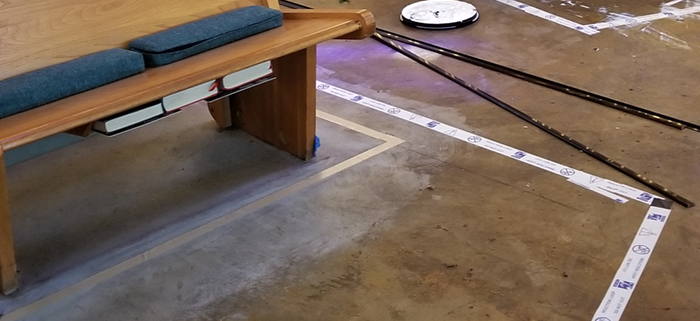Audio, Acoustics, and Video in the Worship Setting – Part 4
Audio, Acoustics, and Video in the Worship Setting
Part 4: Hearing Assistance
Welcome back once again! Let’s review where we have been thus far:
- Room acoustics and the sound system are forever intertwined in what we call the electro-acoustic system.
- The room’s acoustics must be held in check—no excessive reverberation, no slap or flutter echo—in order for the room to sound right for speech or for acoustic music.
- The sound system must be designed and implemented properly in order to have a chance at working well to communicate speech and, when needed, to properly support music.
- Microphones and loudspeakers must be carefully selected and applied properly in order to pick up the voice properly and to “spread the word” so to speak, evenly, clearly, and naturally to every worshiper.
Okay. Let’s assume that we have done all of the above. Most people report that they can hear very clearly at worship. However, there are a few people who report that although the sound is much better now than in the past, they still have trouble hearing. For them, both volume and clarity are lacking.
Uh-oh! What did we miss? We have gotten everything right up to this point, but one important system design element needs to be accounted for. You see, Aunt Tilly and Uncle Charlie can hear just fine now. They are very happy. The friends they sit next to at worship, on the other hand, are not so happy … yet.
Rose and Harry are getting up in years, and for both of them hearing is more difficult than it used to be. Rose has hearing aids. Harry will be getting them soon. They have also heard that some folks younger than they need help as well. They are not complaining about the new sound system; they just realize that they need some more help than others to hear well. For them, the ambient noise in the reverberant space is too much. The sound from the loudspeakers seems distant. Again, not the fault of the speaker system. These folks just need some more help bringing the sound directly into their ears.
How do we provide assistance for these people—young and not so young—so that they, too, can hear clearly at worship? The answer is to provide a hearing assistance system for them.
There are two prominent methods of delivering the needed assistance: the FM-based system and the inductive loop system. Many pastors and others already know the FM-based method well and have it in their churches. The loop system is becoming well-known and popular. Let’s take a look at both and see how they fit into sound system designs.
But first, a hearing assistance “gotcha.” Folks complain that they cannot hear well at worship. The pastor and church leadership approve the purchase of an FM-based hearing assistance system. It works well. A number of folks who use the system are quite satisfied with the improvement. But other people still complain that they cannot hear well. Turns out, the problem is with the sound system itself. The church leadership fell into the trap of buying the hearing assistance system as a cheap “band-aid” which in reality did not solve the root problem: a bad overall sound system.
Implementation of a good sound system meant that some with mild hearing loss no longer needed special assistance.
I have been in several situations where implementation of a good sound system meant that some with mild hearing loss no longer needed special assistance. Here’s an anecdote to illustrate the point.
The first installation that I was involved with was 35 years ago: St. Paul’s in New Ulm, MN. Our company was under contract to install a new sound system at the church. It was for its day (1986) a very good system (though admittedly not visually attractive by today’s standards)—a central horn cluster designed to cover the space evenly, which it did well. An elderly gentleman in the congregation donated the funds for the addition of an FM-based hearing assistance system. He said that he and others needed the help.
We completed the installation enough to where we could debut it—including the hearing assistance—for Thursday evening worship. The donor gentleman came to worship and was met at the door with a hearing assistance receiver. After worship, he returned the receiver and said, “I don’t need the help. This is the first time in 30 years I’ve been able to hear the sermon.”
The moral of the story: Make sure that your sound system is up to par first, and then implement the hearing assistance system for those that really need it!
Who really needs the help? As stated above, Harry, Rose, and some younger folks are experiencing hearing issues at worship. Younger folks? Really? Are they just not paying attention?
I’ve attended a number of seminars dealing with hearing loss, the ADA (Americans with Disabilities Act), and sound system design. Presenters throw around statistics without referencing anything. But a quick Google search leads to the World Health Organization Web site with a wealth of up-to-date information. A few highlights and another anecdote:
- Specific to the United States, over 36 million people (more than 17% of the population) experience measurable hearing loss, or the inability to hear sounds of 25 dB or less in the speech range (referenced to 0 dB as the threshold of human hearing and 70 dB as normal speech from about two feet from the talker). The numbers balloon when expanding to a worldwide view. This compares to about 1.4% of the U.S. population with physical disabilities and 0.14% with visual disabilities.
- Hearing loss results from a number of causes: genetics, infectious disease, use of drugs, chronic ear infections, exposure to excessive noise, and aging.
- Hearing loss affects not just older people. Worldwide, 1.1 billion young people age 12-35 either suffer from or are at risk of measurable to debilitating hearing loss due to noise exposure in recreational settings (concerts and listening devices with earphones top the list of causes).
- It is reported that 60% of hearing loss in children is preventable.
- Over the past 30 years I have had to bring bad news to more than a few teenagers who were willing to help run sound at church or at the high school. I could not allow them to operate the mixing console. The simple reason: those kids could not hear feedback above 2000 Hz. The admitted cause: hours of listening to their devices with earphones. 30 years ago it was the Walkman cassette player; today it’s the smartphone or iPod). The constant pressure on the ear’s mechanics had severely impacted their ability to hear high sounds such as consonants, ‘s’ sounds, and even feedback in a sound system.
Hearing loss issues are real, and they are not exclusive to older people.
So yes, hearing loss issues are real, and they are not exclusive to older people. It is critical that we a) get the sound system right, and b) add hearing assistance for those who need it, because they do need it. And the number who need it grows by the day.
How does the hearing assistance system work? In simple schematic form, we route a feed directly from the mixer or signal processor to the “driver” of the assistance system (see below).
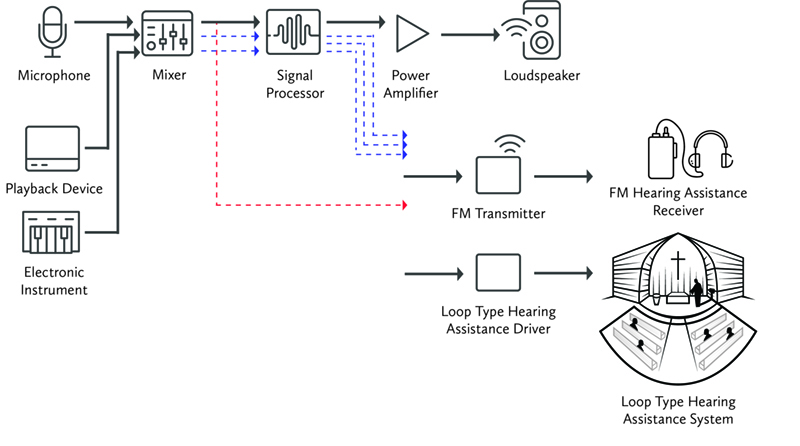
Diagram of a hearing assistance system
That direct connection is critical to the success of any hearing assistance system. Let’s now get into the FM-based and the loop type systems. How do they work? Is one “better” than the other?
First, the FM-based system. “FM-based” means exactly what it says. The system “driver” is a transmitter that operates on a single FM radio frequency. It’s a single-channel radio station. The sound signal is transmitted through the air to a pocket-sized receiver used by the worshiper. There are several types of antennas to attach to the transmitter based on the size of the space to be transmitted into. On the receiver end, the user can choose from several types of earphones based on preference and health concerns—ear buds, headphones, etc.
The advantages with the FM system are ease of setup, potential broadcast range, relative convenience, and cost-effectiveness. In terms of setup, the FM system is basically plug-and-play. You turn up volume and position the antenna properly. Depending on the physical structure of the building and the presence of interference-causing electrical devices, the FM system may not be limited to just the church proper. Going back to the church in New Ulm, the pastor’s mother was in town for Christmas but was limited in terms of mobility. The FM system “reached” across the street to the parsonage so she could hear the Christmas service. That scenario is not typical, but radio is radio. The FM system is generally very cost-effective, ranging from $1,800-$2,500, including professional installation.
The downsides to the FM system are interference and inherent misuse by the user. First, the FM system is a very small, limited-range radio station and radio receiver system. As such it is subject to all of the things that annoy us when listening to the car radio. If the “air” is not “clean,” interference may be problematic. Reflections of radio waves off metal support structure can cause distortion and dropouts. And since this is simple radio, the FM system at your church may at inconvenient times receive from a similar FM system at the church down the street, and vice versa.
Second, many FM assistance users with hearing aids actually misuse the system. The proper use is to remove the hearing aid and “plug” the ear bud or earphone into the bad ear. Many folks, however, plug the earphone into the good ear and then turn it up. Since the hearing aid has a microphone built into it, the sound from the earphone creates a feedback loop with the hearing aid which is often audible throughout the church nave. There are “loop” type necklace accessories that will plug into an FM receiver, effectively turning the FM system into a loop system for that user. However, keep in mind that the interference and other issues that arise with FM are transmitted through that necklace device.
A third downside to FM is that it transmits sound that is not colored or tonally equalized. The user has hearing aid(s) that have been tuned for that person’s ear(s) to compensate for hearing loss at specific frequencies. Without the hearing aid to “tune” the sound, the sound quality may not be adequate to significantly improve clarity for the user.
Lastly, people have become very conscious of how the earbud looks. The fear with many users is that they will stick out in the crowd because they have this earphone or earbud with its cord hanging out for all to see. That aesthetic stigma prevents many from using the FM system.
There are variations on the FM theme today in which wi-fi adjuncts to the system are utilized. Using wi-fi and Bluetooth with a smartphone, the user can receive very good sound quality without the wires. For older users who have difficulty with smartphones and wi-fi technology, this may be cumbersome. For younger users who embrace technology, this may be a cost-effective option.
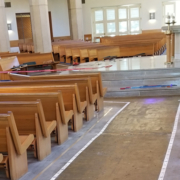 Let’s move to the inductive loop system. While still fairly simple in concept, there is a bit more going on here than with the FM system. We still directly connect a sound system mixer output to a “driver.” But in this case it is not a transmitter. We are actually using wire to create an electro-magnetic field to transmit the sound signal. The photos to the right show a church re-carpeting project of which a hearing loop is system is a part. The white strips on the floor are tape covering the loop wire.
Let’s move to the inductive loop system. While still fairly simple in concept, there is a bit more going on here than with the FM system. We still directly connect a sound system mixer output to a “driver.” But in this case it is not a transmitter. We are actually using wire to create an electro-magnetic field to transmit the sound signal. The photos to the right show a church re-carpeting project of which a hearing loop is system is a part. The white strips on the floor are tape covering the loop wire.
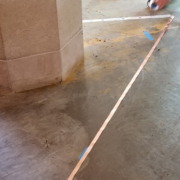 The wire is routed in either one or multiple loop circuits around the seating area. The electro-magnetic field is picked up by the telecoil in one’s hearing aid or cochlear implant. The signal is then converted back into acoustic energy by the telecoil, tuned by the micro-electronics in the hearing aid, and transmitted into the user’s ear. Hence, one advantage with the loop system: the user wears nothing extra. He or she simply switches on the telecoil in the hearing aid, making use extremely convenient and inconspicuous, while delivering sound to the ear that is “tuned” for that ear.
The wire is routed in either one or multiple loop circuits around the seating area. The electro-magnetic field is picked up by the telecoil in one’s hearing aid or cochlear implant. The signal is then converted back into acoustic energy by the telecoil, tuned by the micro-electronics in the hearing aid, and transmitted into the user’s ear. Hence, one advantage with the loop system: the user wears nothing extra. He or she simply switches on the telecoil in the hearing aid, making use extremely convenient and inconspicuous, while delivering sound to the ear that is “tuned” for that ear.
But…the loop system is not plug-and-play like the FM system. Because we are dealing with electro-magnetics, we must study the space. What is in the floor structure: concrete, rebar, metal ducts, electrical wire and conduit, large water or gas pipes? These metal objects in the floor will actually “compete” with the loop wire by generating their own current fields. The “competition” manifests itself in buzz and hum that is audible to someone using a hearing aid. We can measure and hear that using an app with a telecoil adapter, which enables us to see and hear any noise before laying out a loop system. The photo below shows the app screen. If the needle goes into the green range, we are good—very little or no noise/hum. When we get into the yellow and then red, then the hum would be significant and render a loop system unusable. That’s the benefit of testing before installing the loop.
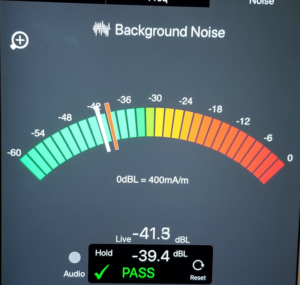
A reading of background noise heard as a buzz on a hearing aid
The loop may be a simple single-loop system or it may be a figure-eight loop, or many smaller loops overlapping in what is called a “phased array” to create one field. The complexity of the loop is dictated by noise/hum in the floor, and by the presence of electronic instruments such as guitars and keyboards that might be used within close proximity of the loop. These instruments will generate significant amounts of noise/hum, which only a more complex loop will overcome.
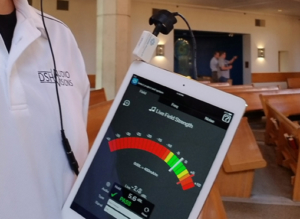
Measuring the hearing assistance system after installation
If I or another loop designer has done the job properly, then the result will be an “invisible” system that allows the user to walk in, flip a switch on the hearing aid, and hear the service clearly with sound tuned for the user’s own ears. The “after” measurement of a completed system is shown in the photo to the right. Green on the meter is always very good!
The advantages are as stated above: invisible equipment, no wires or extra “stuff” that could create an aesthetic stigma for the user, and the ability to pick up sound tuned for their ears. By the way, pocket-sized telecoil receivers are available for those who need assistance but do not have hearing aids. Additionally, the range of the loop system is limited to the area within the loop. We will not be able to transmit to the parsonage across the street. But on the other hand, we will not be susceptible to interference from the church down the block.
The downsides to the loop system are cost and labor. The best time to lay a loop system is during a construction or a renovation project. Otherwise, cutting of existing floor tile or carpet is necessary. (Some loop installers have installed systems to floors with tape, but this is unsightly to say the least.) Necessary testing and the loop layout/design must be carried out by a professional. The installation requires trained technicians. In some areas, certified audiologists may wish to certify the installation. This all comes at a cost. A well-designed and installed loop system will cost $7,000-$20,000, depending on room size and the required loop complexity.
My job here is not to pick a best option for you. I am simply laying out the two most prominent options for your consideration. For performance and aesthetic reasons, I believe that the loop system holds the advantage over the FM system. But the loop may not work in some churches. (We just completed a major sound renovation at the Basilica at the University of Notre Dame; the loop system was not an option due to the floor structure.) The congregation must ultimately decide which is best for its purposes.
For performance and aesthetic reasons, the loop system holds the advantage over the FM system.
My strong opinion, however, is that to not provide hearing assistance is not an option for churches. While technically the ADA does not apply to churches for this purpose as they are still considered private spaces, the real issue of hearing impairment is here to stay. And it is growing. It is our duty to enable Harry, Rose, and all those who need help to hear the Word clearly, just as we provide good sound systems with good loudspeakers for Aunt Tilly and Uncle Charlie.
I have seen “happy tears” in the eyes of people who finally can again hear the liturgies and sermons that were becoming more and more unintelligible. I look forward to seeing many more of those kinds of tears!
WORSHIP
Learn about how WELS is assisting congregations by encouraging worship that glorifies God and proclaims Christ’s love.
GIVE A GIFT
WELS Commission on Worship provides resources for individuals and families nationwide. Consider supporting these ministries with your prayers and gifts.
[fbcomments num=”5″]

